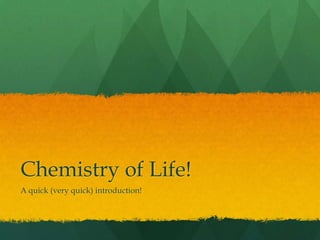Chonps
•Télécharger en tant que PPTX, PDF•
2 j'aime•1,990 vues
Carbon has a central role in living organisms due to its ability to combine with itself and other elements in many ways. Organic compounds contain carbon and can be linked together to form polymers, which are long chains of repeating molecules. Important polymers include proteins, DNA, and synthetic polymers like plastics. Living things are primarily made of molecules containing carbon, hydrogen, oxygen, nitrogen, phosphorus, and sulfur.
Signaler
Partager
Signaler
Partager

Recommandé
Recommandé
Reduction of carbon dioxide into value added fuels and chemicals has been an interested field of research both in terms of energy as well as in environmental point of view. In photocatalytic reduction, in principle, the material harnesses the natural sun and atmospheric carbon dioxide in a sustainable pathway and convert it into chemicals and fuels, which requires a series of electron and proton transfer reactions, a style similar to the natural photosynthesis. Only the fruition of the technology, even in research laboratory scale is still a challenge due to the ‘n’ number of hurdles associated with the procedure. The mechanistic aspects are yet not readable or the current knowledge is not sufficient to explain the exact reaction mechanism. Amazingly, no arguments or controversies going on these issues among the scientific community. Out of all ‘n’ number of hurdles, here we are debating the mystery behind the mechanistic aspects of CO2 reduction. On what we know and what we don’t know about the photocatalytic conversion of...

On what we know and what we don’t know about the photocatalytic conversion of...Hariprasad Narayanan
Contenu connexe
Tendances
Reduction of carbon dioxide into value added fuels and chemicals has been an interested field of research both in terms of energy as well as in environmental point of view. In photocatalytic reduction, in principle, the material harnesses the natural sun and atmospheric carbon dioxide in a sustainable pathway and convert it into chemicals and fuels, which requires a series of electron and proton transfer reactions, a style similar to the natural photosynthesis. Only the fruition of the technology, even in research laboratory scale is still a challenge due to the ‘n’ number of hurdles associated with the procedure. The mechanistic aspects are yet not readable or the current knowledge is not sufficient to explain the exact reaction mechanism. Amazingly, no arguments or controversies going on these issues among the scientific community. Out of all ‘n’ number of hurdles, here we are debating the mystery behind the mechanistic aspects of CO2 reduction. On what we know and what we don’t know about the photocatalytic conversion of...

On what we know and what we don’t know about the photocatalytic conversion of...Hariprasad Narayanan
Tendances (20)
Degradation of Low Density Polyethylene Due To Successive Exposure to Acid Ra...

Degradation of Low Density Polyethylene Due To Successive Exposure to Acid Ra...
Electrochemical synthesis, characterization and electrochemical behaviour of...

Electrochemical synthesis, characterization and electrochemical behaviour of...
On what we know and what we don’t know about the photocatalytic conversion of...

On what we know and what we don’t know about the photocatalytic conversion of...
Effect of metal dopant on photocatalytic performance of TiO2 nano particles 

Effect of metal dopant on photocatalytic performance of TiO2 nano particles
En vedette (6)
B.Sc. Biochem II Biomolecule I U 3.1 Structure of Proteins

B.Sc. Biochem II Biomolecule I U 3.1 Structure of Proteins
Similaire à Chonps
Similaire à Chonps (20)
History, Classification, Uses of organic chemistry

History, Classification, Uses of organic chemistry
Introduction to inorganic polymers by Dr. Salma AMIR

Introduction to inorganic polymers by Dr. Salma AMIR
Plus de MrsKendall
Plus de MrsKendall (20)
Chonps
- 1. Chemistry of Life! A quick (very quick) introduction!
- 2. Carbon! It’s special! Because of it’s very special ability to combine in many ways with itself and other elements it has a central role in the chemistry of living organisms!
- 3. Forms of pure Carbon Diamond (Crystalline form) Graphite (Many flat layers; easily slide) Fullerenes (Sphere shaped) Nanotubes (long, hollow cylinder)
- 4. Organic Compounds Organic compounds are compounds that contain carbon. Originally, scientists believed that organic compounds only had to do with living organisms. That is no longer believed to be true. Many organic compounds have similar properties in terms of melting points, boiling points, odor, electrical conductivity and solubility.
- 5. Polymers! A long repeating chain of molecules is called a Polymer. Organic compounds can be linked together to build polymers with thousands or even millions of atoms in one strand. Polymers form when chemical bonds link large numbers of monomers (smaller molecules) in a repeating pattern.
- 6. More Polymers! Synthetic Polymers: Plastics Glue Chewing Gum Synthetic fabric Natural forms of Polymers: Amino Acids Proteins DNA!!! Silk!
- 7. CHONPS! Living organisms are made of molecules consisting largely of: Carbon Hydrogen Oxygen Nitrogen Phosphorus Sulfur